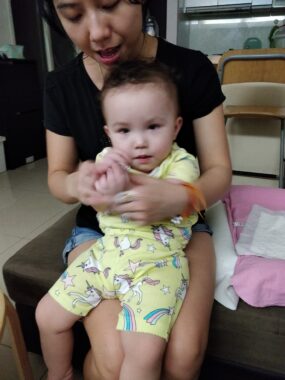Sitting behind our daughter helped her build strength, life skills
The support was crucial to enhancing her safety, comfort, and engagement
Written by |

Our daughter, Rylae-Ann, failed to meet her milestones at 3 months old. From that point on, she was limp and barely moving. However, she was still very much full of life, and my wife, Judy, and I would help her to still experience the world.
Even before we learned Rylae-Ann had aromatic l-amino acid decarboxylase (AADC) deficiency, we began to support her in experiencing the world around her. This required us to act as puppeteers so she could play with toys, but for more practical activities like eating and drinking, we had to be creative in finding solutions that would allow her to accomplish these necessary tasks.
We began to study strategies used in occupational therapy (OT), which focuses on helping patients accomplish meaningful activities that they need for daily life. The goal of occupational therapy is to enable people to live life as independently and fully as possible.
Benefits of sitting behind our daughter
A key strategy that we could apply to various situations was the simple act of sitting behind our daughter. At face value, this may not seem like anything exceptional. However, this approach allowed us to better care for her and make steps toward improvement until she eventually achieved sitting independence.
Being seated behind Rylae-Ann provided her with a stable support base. She couldn’t sit on her own, and if we weren’t behind her, she would instantly tip over to her side because of her low muscle control and strength.
Our chest would act like the back of a chair, encouraging proper postural alignment. Often, our fingers would press on her shoulders to prevent slouching. Over time, we could ever so slightly adjust how much support we were giving her.
In this position, we could also do exercises and practice leaning side to side to improve her balance and strength. The progress was slow, but even without seeing progress, we knew supporting her in this position was more natural and enjoyable.
Acting as a shell also added an element of safety and security. This was particularly useful for new activities or items that challenged her sensory processing issues. In the beginning, colorful dough was an untouchable item. Over time, she would giggle endlessly as we used her hands to interact with the clay.
The activities
Sitting behind Rylae-Ann allowed us to interact closely with her. This tandem proximity facilitates communication, bonding, and engagement while achieving her OT goals. We would also use this time to read books, play games, or practice other therapy goals.
Later, we extended this position to other large movements. For example, Judy and I worked as a team to move Rylae-Ann from a sitting to a standing position. This required a lot of support, so this step came after we felt confident in our abilities as well.
Being positioned behind Rylae-Ann enabled us as caregivers to observe her posture, movements, and behavior closely. Overall, sitting behind our daughter enhanced her feeling of safety, comfort, and engagement during seated activities while also allowing us to guide and monitor her OT development.
Note: AADC News is strictly a news and information website about the disease. It does not provide medical advice, diagnosis, or treatment. This content is not intended to be a substitute for professional medical advice, diagnosis, or treatment. Always seek the advice of your physician or other qualified health provider with any questions you may have regarding a medical condition. Never disregard professional medical advice or delay in seeking it because of something you have read on this website. The opinions expressed in this column are not those of AADC News or its parent company, Bionews, and are intended to spark discussion about issues pertaining to aromatic l-amino acid decarboxylase deficiency.








Leave a comment
Fill in the required fields to post. Your email address will not be published.